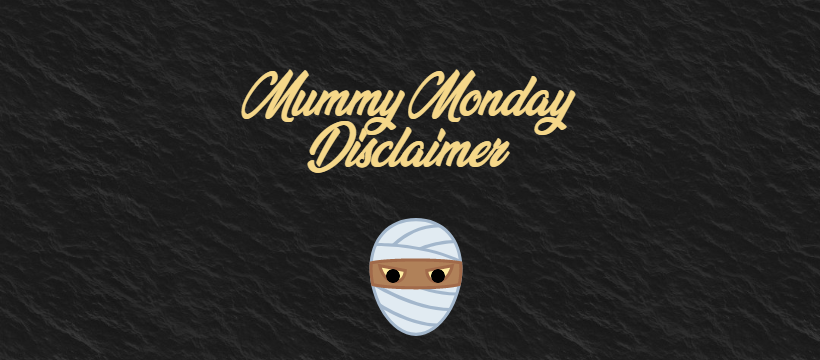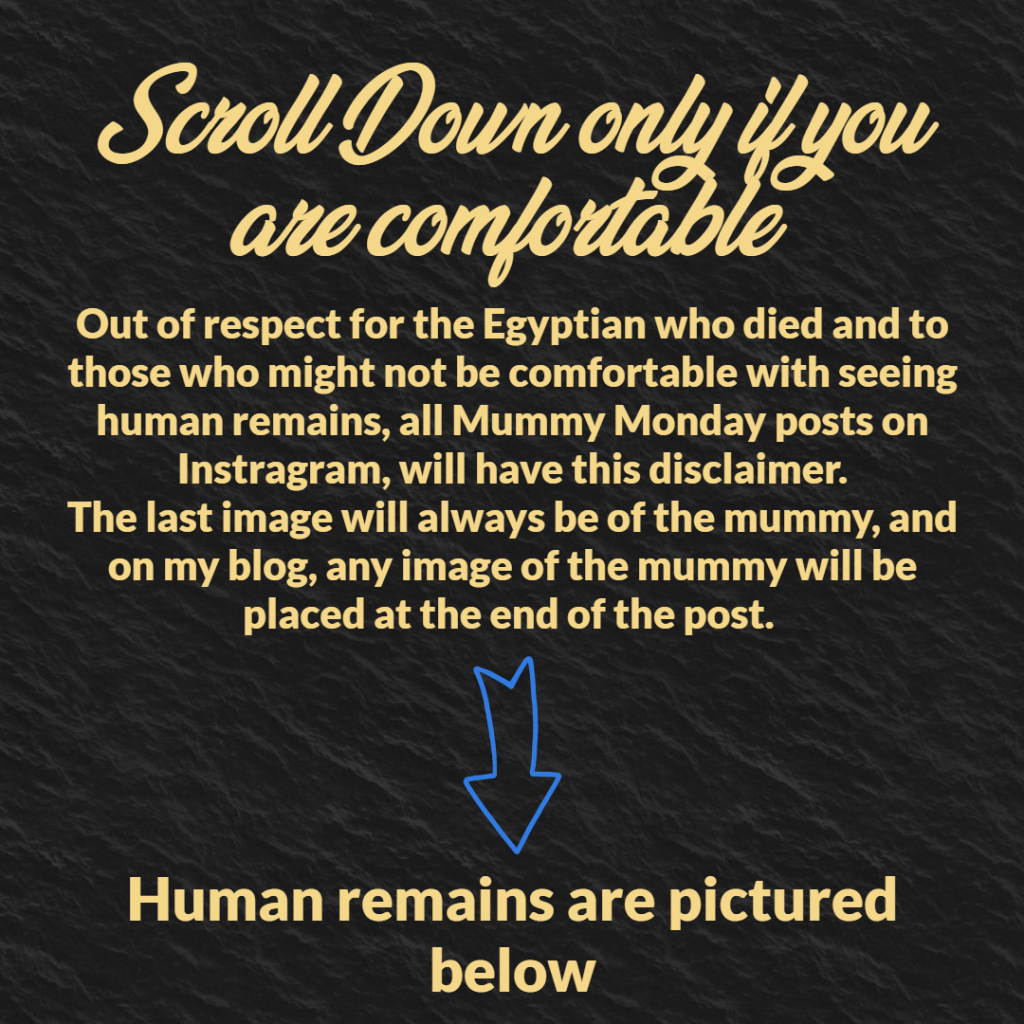This week I’d like to introduce you all to a mummy from the Ptolemaic Period, which is the period when Egypt was under the rule of the Greek Ptolemaic pharaohs. His name is Hornedjitef and he was a priest of Amun.
Life
Little is known about Hornedjitef’s life because it is not exactly known where he was buried. His coffin was most likely excavated around 1825 in the Asasif area of Thebes. This is a cemetery area on the road leading to the Mortuary Temple of Hatshepsut in Deir el-Bahri. Although I said it was excavated, this was not done following modern archaeological techniques. If it was, the tomb’s location, size, layout, and decoration would have been recorded along with the cataloging of all the objects found in the tomb.

All we know is that coffin and a few objects were found together and collected by Henry Salt, who was the British Consul-general in Egypt in 1815 and a collector. His collection was mainly housed in Egypt before his death. In 1935, part of his collection was brought to England to be sold by the auction house Sotheby’s. Here the British Museum purchased the coffin, mummy, and some of the associated items for £320.
We know from his Book of the Dead fragments that his parents were Nekhthorheb and Tadineferhotep. He held multiple religious titles, indicating that he was a high ranking religious figure. He was a Priest of Amun at the Temple of Karnak in Thebes, Prophet of Min, Prophet of Khons, and Overseer of the Burnt Offerings of Amun. He lived during the reign of Ptolemy III which dated from 246 to 222 B.C.E.
As a priest, he would have worked in the various temples in Karnak performing a variety of sacred rituals every day. The priests had to wash and “feed” the statues of the gods in the temples.
Associated Artifacts
As I just mentioned, some of the items from Hornedjitef’s funeral assemblage were kept with the coffin and mummy. These are a Book of the Dead papyrus, a painted wooden figure of Ptah-Sokar-Osiris, and a hypocephalus.
The Book of the Dead is a funerary text which was customized for the deceased. Different spells or instructions were chosen to help the deceased navigate the afterlife. Hornedjitef’s Book of the Dead is in eight fragments in the British Museum (EA10037,1-8), although only the first three have been photographed. They are quite simple designs, using only black and red ink. The images show the deceased giving offerings to his parents and his funeral procession. Priests are anointing his mummy, carrying the coffin on a barge, and preparing his funeral assemblage for burial. Following the procession are mourning women, crying out against his death.
The wooden statue of Ptah-Sokar-Osiris (EA9736) is typical of this period. This god is one of the forms of the god of the dead, who is wrapped up like a mummy. Usually, he wears a feathered headdress, but that seems to be lost. His face is covered in gold leaf, which addressed the Egyptian belief that the gods had golden skin and hair of lapis lazuli. A small figure of a falcon mummy, representing Sokar, sits in front of the god, protecting a secret compartment that contains a tiny piece of rolled-up papyrus. The piece is covered in the Egyptian offering formula, which symbolically gives the deceased a portion of the offerings the king gives to the gods daily.

A hypocephalus is an interesting object that is related to a specific spell of the Book of the Dead. This is an inscribed disc that was placed under the heads of mummies during the Late Period and Ptolemaic Era. The texts are taken from spell 162 of the Book of the Dead and were intended to provide heat to ensure the resurrection of the dead. Images of a variety of deities would help the potency of the texts. This hypocephalus (EA8446) was made of plaster over linen, but it could be made out of papyrus or bronze. A four-headed ram god called Banebdjedet of Mendes, baboons, and barque are all featured.
The only object of Hornedjitef that is not located at the British Museum is the canopic chest. This (AH 215) is located at the Rijksmuseum van Oudheden in Leiden, Netherlands, but it unclear if they purchased it from the sale at Sotheby’s or from another seller. By the Ptolemaic Era, the embalmed entrails were not kept in the four canopic jars but small wooden chests in the form of a shrine or naos. The chest consists of a square base with four painted side panels that slope upward. A hollow cornice is placed on top as the lid with another image of the god Sokar. All four sides are painted with images of the four sons of Horus, the winged scarab god, Khepri, and Anubis giving offering presumably to the head of Hornedjitef.
Sarcophagi
The mummy is housed inside two different coffins. The outer coffin (EA6677) is quite simple in comparison, though it is massive compared to the inner coffin. The massive size may have been to indicate his wealth and high status or as a way to protect the burial from robbery. It has a painted black surface with details painted yellow. The color black was associated with Osiris and was seen as a color of regeneration and fertility. The decoration includes a large broad collar, images of Isis and Nephthys mourning over the deceased, and inscriptions from the Book of the Dead. The bottom part of the outer coffin has an image of the goddess Nut, who would help protect the mummy. It also symbolizes Hornedjitef in the womb of the goddess, ready to experience a rebirth into the next world.
The inner coffin (EA6678) is a striking contrast to the outer coffin in terms of decoration. It had a fine gilded face with a curled tapering beard. The broad collar is vivid with terminals (the end portion of the necklace) in the form of falcon heads. In the center of the collar, there is an image of the ba, which is a piece of the Egyptian soul, and a pectoral ornament that contains a scene of Hornedjitef adoring four deities. Below the collar is an image of the sun god as a winged scarab beetle, flanked by baboons. The funerary text runs down the middle of the coffin, with the four sons of Horus, Isis, and Nephthys on either side.
The interior of the lid contains an elaborate version of the Egyptian sky, as the lid of a coffin was symbolically identified with the heavens as it stretched above the deceased. The goddess Nut is pictured here frontally, stretching over the mummy. Chapter 89 of the Book of the Dead is written all over her body. To the left, there is a list of the planets and the stars that helped the Egyptians tell time. And to the right are the constellations of the northern hemisphere. On the bottom of the interior, there are two images of Anubis and two bound prisoners. This symbolizes the deceased’s triumph over the enemies of Egypt or the forces of chaos that might try too hard Egypt or threaten his survival in the afterlife.


Mummy
Now this mummy is a little different than the previous mummies we have looked at. Although it was found in the early 1800s, this mummy was never unwrapped. Most mummies were unwrapped during this time, which has led to further damage over the years. But because this mummy has not been unwrapped, modern scholars have to use some more complicated techniques to learn about the body.

But first, let’s talk about the beautiful cartonnage cover and mask on this mummy (EA6679)! The surface is decorated in a material called cartonnage, which is made out of layers of linen and west plaster which dried solid. It was then painted blue, gilded, and decorated with traditional funerary scenes. On the bottom of the feet of the coffin, the soles of the feet of the deceased are painted with images of two bound prisoners, mirroring the image inside the lid of the inner coffin.
The mask was made separately. It shows the idealized face of a young man, although his beard is missing. His skin is glided, implying that he had become divine like the gods. Around his brow is a version of a spell in which parts of his head are identified with the bodily members of various gods. This was done to protect the head from being separated from the body, which would prevent the deceased from reaching the afterlife.
To examine the mummy, the British Museum staff took x-rays and a CT scan of the mummy. They were able to determine that Hornedjitef was probably 55 to 65 when he died. He did not seem to have any fractures, dislocations, or lines of arrested growth. But he did have arthritis and osteoporosis in his spine, which would have caused him great pain. His arms were flexed at the elbows, with the forearms crossed over his upper abdomen.
Although a canopic chest for Hornedjitef has been found, his internal organs were not placed in it. When the chest was opened, there were just pieces of broken pottery. Through the CT scan, scholars were able to see that he had four cylindrical packages of linen and resin, which most likely contained his organs. His heart was also left within his chest, which was traditional of Egyptian mummification because they believed that they thought with their heart and not their brain. There was also a heart scarab placed over his chest, though it seems to have shifted toward his shoulder. After his brain was taken out (through his nose, if you didn’t know!), the skill was filled with rein, which you can see in the CT image. The resin settled in the back of his skull, indicating that the body was lying on his back when it was poured in.
His legs were individually wrapped, and a small pad can be seen between them. Besides the heart scarab, he was also wearing some jewelry. He seems to be wearing a ring on his left hand, a large gold ring on the big toe of his left foot, and some anklets on non-metal material. The scholars also used these scans to put a 3D image of the Hornedjitef’s face together. The top of his head couldn’t be scanned because of the way his head lies to one side.

Legacy
In 2010, the coffin and mummy of Hornedjitef were selected by British Museum Director Neil MacGregor as the first of 100 objects for a BBC Radio 4 series, A History of the World in 100 objects. You can listen to the clip here and read the transcript here.
Also read this amazing booklet by Joyce Filer which covers even more about Hornedjitef, his mummy, and the time period he lived in!
Sources
https://en.wikipedia.org/wiki/Hornedjitef
https://mummipedia.fandom.com/wiki/Hornedjitef
https://sites.google.com/site/100objectsbritishmuseum/home/mummy-of-hornedjitef
https://artsandculture.google.com/asset/outer-coffin-of-the-priest-hornedjitef/HgEkSGZo6bq9qw?hl=en
https://artsandculture.google.com/asset/canopic-chest-of-hornedjitef-unknown/GQEyRicBwCqseQ?hl=en
https://artsandculture.google.com/asset/mummy-of-hornedjitef-inner-coffin/vgHJIobGkBxTQg?hl=en
https://artsandculture.google.com/asset/mummy-mask-of-hornedjitef/2AGO7uWLu0VOgQ?hl=en
https://donsmaps.com/egypt4.html
https://joycefiler.wordpress.com/2013/06/30/henry-salt-collector-of-heroic-proportions/
https://www.britishmuseum.org/collection/object/Y_EA6677
https://www.britishmuseum.org/collection/object/Y_EA6678
https://www.britishmuseum.org/collection/object/Y_EA6679
https://www.britishmuseum.org/collection/object/Y_EA9736https://www.britishmuseum.org/collection/object/Y_EA10037-1
https://www.britishmuseum.org/collection/object/Y_EA10037-1
https://www.britishmuseum.org/collection/object/Y_EA10037-2
https://www.britishmuseum.org/collection/object/Y_EA10037-3
https://www.britishmuseum.org/collection/object/Y_EA10037-4
https://www.britishmuseum.org/collection/object/Y_EA10037-5
https://www.britishmuseum.org/collection/object/Y_EA10037-6
https://www.britishmuseum.org/collection/object/Y_EA10037-7
https://www.britishmuseum.org/collection/object/Y_EA10037-8
https://www.britishmuseum.org/collection/object/Y_EA8446
https://www.rmo.nl/en/collection/search-collection/collection-piece/?object=22520
http://www.bbc.co.uk/ahistoryoftheworld/objects/sogITE3FSKStlk12qd2W3w
Photo Credits
Sarcophagus, Mummy, Papyrus, Hypocephalus, and wooden statue – British Museum
Canopic Chest – Rijiksmuseum van Oudheden
X-ray, CT scans – Joyce Filer book
Map of Theban Necropolis – http://www.touregypt.net/featurestories/westbank.htm














































